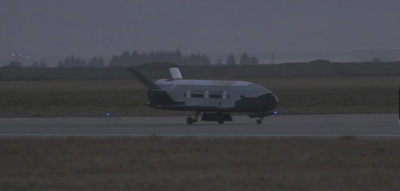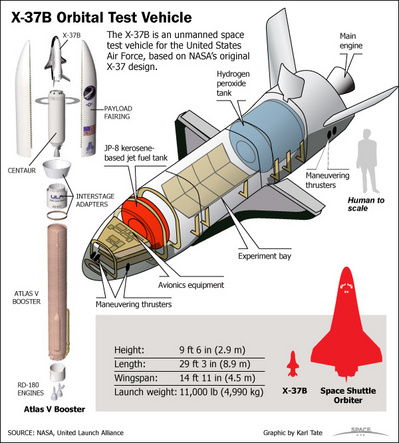
先週土曜日、カリフォルニアのヴァンデンブルグ・アメリカ空軍基地にX-37B無人宇宙船が戻ってきたそうです。昨年、3月5日にフロリダ州から打ち上げられ、9か月のミッションのところ469日間の無人フライトを敢行したそうです。太陽光発電、過酸化水素、既存のジェット燃料が主な燃料源のようです。
X-37Bはスペースシャトルのミニチュア版みたいなサイズで、現在のところ荷室はピックアップ・トラック程度しかありません。1990年代からボーイング社とアメリカ空軍で共同開発しており、次期スペースシャトルと捉えてイイんでしょう。国際宇宙ステーションへの物資輸送、はたまた無人偵察スパイとしての活用法も見出されているとか。最近、アメリカは無人偵察機を街でも飛ばしていますし、無人爆撃機も大活躍・・・。
ただ、予算削減が進むなか、本当にどのように活用されるのかは公になっていません。しかし、次の打ち上げは決まっているようです。X-37B自体が今後の宇宙活動に本格導入されるのか、はたまたX-37Bで培った技術がほかに生かされるのか・・・、いやはや凄い時代です。

Our View
The Air Force’s X-37B robotic space plane made its landing at California’s Vandenberg Air Force Base Saturday morning successfully completing more than 15 months in space. This is the second X-37B to take flight (OTV-2), following in the footsteps of a sister plane’s test flight in 2010. The OTV-2 had launched from Cape Canaveral, Florida on March 5, 2011 and though built to operate for nine months at a time in between servicing, it exceeded the mission parameters with its 469 day run.
The Boeing-built X-37B has been in development since the 1990s and was designed to be a research vehicle, carrying experiments as its payload. It is thought the X-37B could be used for a variety of purposes, anything from cargo delivery to the ISS to potential spying missions. Budget cuts and funding being diverted to other programs make it unlikely that Boeing and the Air Force would move forward on the creation of new models, much less the proposed proposed X-37C which could carry a bigger payload and crew.
In the short term, the Air Force plans to re-launch the OTV-1 this fall and is considering plans for the OTV-2, with an eye towards continued endurance and operational improvements. We wonder where the technology gained by this mission will be used…
 CarKingdom.jp(自動車王国)
CarKingdom.jp(自動車王国) 







